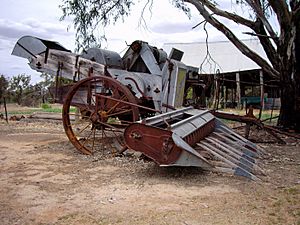Combine harvester facts for kids
The combine harvester, often just called a combine, is a super useful machine. It's built to harvest many different kinds of grain crops really well. Its name comes from how it combines three important farming jobs into one machine:
- Reaping: This is when the machine cuts and gathers the crops when they are ready.
- Threshing: This part separates the yummy, edible grain from the parts of the plant you can't eat.
- Winnowing: After threshing, this step blows away the light, unwanted parts (called chaff) and leaves only the heavy, good grain.
Some of the crops a combine harvester can gather include wheat, oats, rye, barley, corn (maize), sorghum, soybeans, flax (linseed), sunflowers, and canola. After the combine does its work, the leftover dry stems and leaves are called straw. This straw can be chopped up and spread back on the field to help the soil, or it can be baled into big blocks to feed farm animals or for their bedding.
Combine harvesters are a huge invention because they save so much work. They have greatly reduced the number of people needed for farming. This means fewer people have to work in fields, thanks to this amazing machine!

Contents
History of Combines
Early Inventions
In 1826, a Scottish inventor named Reverend Patrick Bell designed a machine that could cut plants. This machine used a "scissors" cutting method, which is still used in combines today! However, he didn't get a patent for it. Later, in 1835, someone named Moore built a full-sized version of this machine. This early combine harvester was so big it needed 20 horses to pull it, and many farmhands to operate it!
By 1860, American farms were using combine harvesters that could cut a wide path, several meters across. In Australia, Hugh Victor McKay created a very successful combine harvester in 1885. He called it the Sunshine Harvester.
Powering the Machines
At first, large teams of mules or horses pulled these combines. A special wheel called a bullwheel helped power the machine's parts. Later, people started using steam power. George Stockton Berry even made a combine that used straw (the leftover plant parts) to heat its steam engine! By the early 1900s, horse-drawn combines were common in places like the American plains and Idaho. Sometimes, more than twenty horses were needed to pull them.
Self-Propelled Combines
A big step forward happened in 1911 when the Holt Manufacturing Company in California made a combine that could move by itself. This was called a self-propelled harvester. In Australia, in 1923, the Sunshine Auto Header was one of the first self-propelled combines that fed crops into its center.
Another important improvement was the rotary design. Rotary combines were first introduced by Sperry-New Holland in 1975. These machines use a spinning rotor to thresh the grain, which can be very efficient.
Modern Technology
Around the 1980s, combines started getting electronic systems. These systems could measure how well the machine was threshing the grain. This new technology helped farmers get more grain from their fields. Operators could use the information to adjust the combine's speed and other settings to get the best results.
Images for kids
-
An Allis-Chalmers GLEANER L2 combine.
-
John Deere Combine harvesters being transported by railway on flat cars in Tyrone, Pennsylvania, in the United States.
See also
 In Spanish: Cosechadora para niños
In Spanish: Cosechadora para niños

















